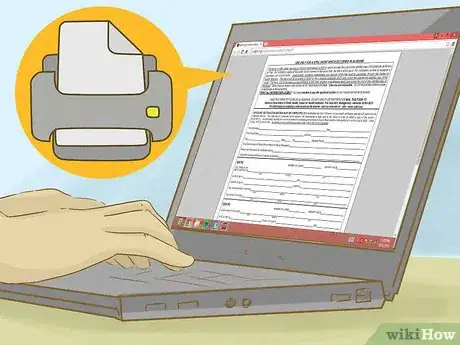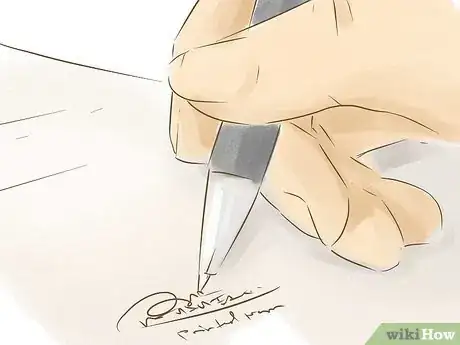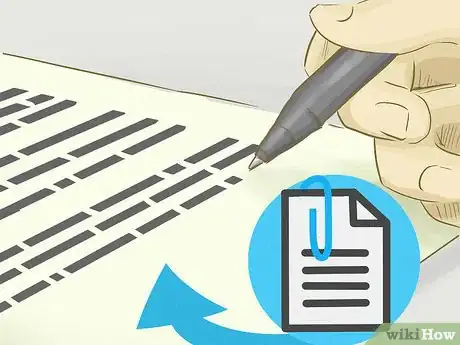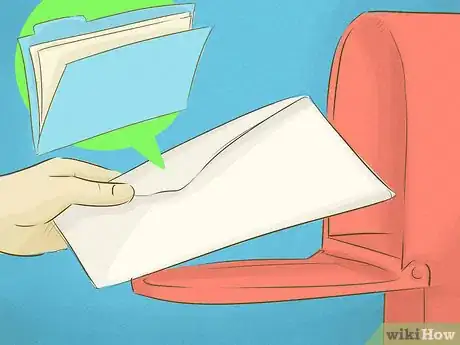This article was co-authored by Clinton M. Sandvick, JD, PhD. Clinton M. Sandvick worked as a civil litigator in California for over 7 years. He received his JD from the University of Wisconsin-Madison in 1998 and his PhD in American History from the University of Oregon in 2013.
There are 7 references cited in this article, which can be found at the bottom of the page.
This article has been viewed 28,949 times.
Even if you have not been convicted, a criminal record of charges or arrests may be detrimental to your getting employment, volunteering, or even getting some loans. If this is happening to you, you may want to try to expunge the items from your record. Expunging will remove certain items, as long as you have not been convicted. In Florida, to expunge items from your record, you should begin with a personal review of your criminal record history. You then need to obtain a Certificate of Eligibility, which verifies that the items you seek to remove are appropriate. Finally, you will need to petition the court for an order to remove the offending items from your record. This is a complicated legal process that you can do on your own, or you may wish to hire an attorney to represent you in the process.
Steps
Reviewing your Criminal Record History
-
1Request a Personal Review of your record. Under both state and federal law, any individual has the right to request a review of that person’s criminal history record. This review is to check the completeness and accuracy of the record. By conducting a personal review, you can find out what items are visible on your criminal history record and decide which items to apply to expunge.[1]
- The procedures detailed here are for a common personal review of your record. If you need a certified copy of your criminal history record, you need to contact the Florida Department of Law Enforcement (FDLE) Criminal History Services by telephone at (850) 410-8109 to make special arrangements. You may also contact them by sending an email to BackgroundChecks@fdle.state.fl.us.
- There is no charge for requesting your personal review of your record.
- The personal review is not required in order to expunge certain items from your record, but it is recommended.
-
2Provide your personal information on the application form. To begin the process, you need to complete the “Application for Personal Review of Florida Criminal History Record.” The form is available at the website of the Florida Department of Law Enforcement (FDLE), at http://www.fdle.state.fl.us/cms/Criminal-History-Records/Documents/PR-and-Challenge-Form_with-print-card_08312016.aspx. Print the application form and provide the following personal information:[2]
- Your full legal name and any other names that you may have used.
- Your current mailing address.
- Your date of birth, gender and race.
- Your social security number and driver’s license number. These are both optional but may assist in identifying the correct records.
- Your contact information. You need to give your daytime phone number, alternate phone number, and an email address.
Advertisement -
3Answer the questions about the reasons for your request. You will be asked if you believe that you have a criminal record in Florida. If so, you should provide your 8-digit state identification number. You will also be asked why you are making the request. If you are requesting your review to expunge certain records, then select “Seal/Expunge.”[3]
- Identify inaccuracies in your record. If you already believe that there are certain items on your record that are questionable, you may provide the date of each arrest and a brief explanation. This step is not required in order to get your personal review.
- Sign and date the application form.
-
4Get a copy of your fingerprints. The last page of the “Application for Personal Review of Florida Criminal History Record” is a blank fingerprint card. You must provide a set of fingerprints to accompany your application. You can have your fingerprints taken at almost any law enforcement office, such as a police department, sheriff’s office, or state police barracks. You should contact the office where you would like to have this done and ask if they have particular times for doing this.[4]
- In addition to law enforcement offices, you can find a list of qualified fingerprint service providers at http://www.fdle.state.fl.us/cms/Criminal-History-Records/Documents/ApplicantLivescanService-ProvidersVendors.aspx.
- There may be an administrative fee for providing the fingerprinting service.
- Call an office near you and ask, “Do you provide fingerprinting services that will support a request for a personal criminal records review?”
-
5Mail in the completed application with your fingerprints. The completed form and fingerprints should be sent by mail to Florida Department of Law Enforcement, Post Office Box 1489, Tallahassee, FL 32302-1489 Attn: Quality Control Section. Be sure that you have signed the application form and that the fingerprint card is completely filled in with your identifying information.
- Save a copy of the completed fingerprint form. You will need it to submit (again) with your application for a Certificate of Eligibility.
- You should receive a response to your request within 30 business days. If you need a faster review, you can call (850) 410-8161 or visit www.fdle.state.fl.us. You can conduct an expedited review for a fee of $24.
-
6Examine your criminal history report. When you receive your report, you should check it for accuracy and completeness. You can also review the record to make sure that the items you wish to expunge are eligible for doing so. You cannot expunge any items for which you have been found guilty or adjudicated as responsible or delinquent. Expunging your record is to remove charges that were subsequently dropped or for which you were found not guilty.
Obtaining a Certificate of Eligibility
-
1Download and print the application form. The first required step in expunging your records is to obtain a Certificate of Eligibility. You begin by printing the application form, which is available on the FDLE website at http://www.fdle.state.fl.us/cms/Seal-and-Expunge-Process/Documents/Seal-and-Expunge-Application_Revised-06152010.aspx.[5]
- When you download the form, it appears on your computer screen in a fill-in format. If you wish, you can type your answers directly onto the form and then print a completed copy. Alternatively, you may print the blank form and then complete it by hand.
-
2Complete Section A of the application form. The application form requests identifying information about you. It is also where you list the dates of items on your criminal record that you believe should be expunged. This information will be reviewed by the district attorney’s office to make sure that you are eligible for having these dates expunged from your record. In completing Section A, provide the following information:[6]
- Name. Include any aliases or maiden name, if applicable.
- Telephone numbers.
- Date of birth.
- Race.
- Sex.
- Social security number. The FDLE notes that failing to provide a social security number may delay processing of your application.
- Florida driver’s license number.
- Mailing and permanent address.
- Arresting agency and date of arrest.
- Charges that you wish to expunge.
-
3Sign the application form. Your signature indicates that all of the information on the application form is correct and that you believe you are eligible to have the records expunged. You must have your signature notarized, so do not sign the application until you are in front of a notary public. The notary public will review your identification, witness your signature, and then affix a state seal verifying the authenticity of the signature.[7]
- To find a notary, you can do a quick search online. You may also commonly find a notary public at banks, public libraries or your city clerk’s office. They may charge a slight administrative fee for their service.
-
4Submit the application with Section A complete to the state attorney’s office. The state attorney in the county where you were charged will need to complete Section B on the application form, before you can proceed. Send the form, with your information in Section A, to the appropriate state attorney’s office. That office will complete Section B and return the form to you. You will probably receive the completed form within about two weeks.
- You can find a link to state attorney addresses, arranged by city and/or judicial circuit at http://www.stateofflorida.com/attorneys.aspx.
- You should call the state attorney’s office before mailing in your form to find out if you should address the form to the attention of any particular individual.
- Keep a copy of the form before mailing, just in case it gets lost.
-
5Obtain a certified copy of your court disposition. For each charge that you wish to have expunged from your record, you must get a certified copy of the final disposition from the court clerk. You can work on this while you are waiting for the state attorney to complete Section B of your application form. To get a certified copy of your court disposition, you will need to request it from the court where your charges were addressed. The court clerk may have a particular form to make such request. You may also be able to make the request in person over the counter.[8]
- To find out about getting a certified copy, you should call the court clerk’s office and ask, “How can I obtain a certified copy of the disposition of criminal charges against me?” You will need to know at least the approximate date that you appeared in court.
-
6Provide the processing fee. An application for a Certificate of Eligibility requires payment of a processing fee of $75. You must include this payment along with your application form. The payment must be in the form of a money order or cashier’s check, made payable to the Florida Department of Law Enforcement (FDLE).[9]
-
7Include a copy of your fingerprints. If you obtained a copy of your fingerprints in connection with the personal review of your criminal history, you may send that same fingerprint card with this application. If not, then you will need to have your fingerprints taken to support your application for Certificate of Eligibility. A blank form is connected to the application on the last page. Take this form to any law enforcement office or other certified fingerprint service agency.[10]
- In addition to law enforcement offices, you can find a list of qualified fingerprint service providers at http://www.fdle.state.fl.us/cms/Criminal-History-Records/Documents/ApplicantLivescanService-ProvidersVendors.aspx.
- There may be an administrative fee for providing the fingerprinting service.
- Call an office near you and ask, “Do you provide fingerprinting services that will support a request for a personal criminal records review?”
-
8Submit your completed application package. When you have all parts of your application ready to submit, you will need to send them to the FDLE for consideration. If you do not submit a full package, your request will either be denied or simply returned to you to resubmit with all the materials. Mail your complete package to Florida Department of Law Enforcement, ATTN: Expunge/Seal Section, P.O. Box 1489, Tallahassee, Florida 32302-1489. Keep a copy of the complete package for yourself before mailing. A complete package should contain all of the following items:[11]
- Completed Application form, with notarized signature and Section B from the State Attorney’s office.
- Payment of $75 fee, in cashier’s check or money order.
- Certified copy of case disposition.
- Fingerprints.
-
9Await a response on your application. The FDLE responds to applications for Certificate of Eligibility as they are submitted. Currently, the FDLE anticipates sending your reply within about 90 days from the date of receiving your application.[12]
Filing a Petition to Expunge Your Records
-
1Consult with an attorney. You may represent yourself through the remainder of the process, but an attorney can assist you with using the correct forms or filing the papers in the appropriate court. You may be able to get assistance from a public defender, if you qualify.
- The attorney from your original criminal trial may be in the best position to help you file the remaining paperwork.
- If you need to find a new attorney, you can begin by asking friends or colleagues for referrals to attorneys they have used. You can also call the Bar Association in your area for a referral. You will want someone with experience in criminal issues, particularly with expunging records.
- Meet with any potential attorney and ask about that attorney's experience handling cases like yours. You can ask, "How many people have you successfully represented in having criminal records expunged?" Find out how familiar the attorney is with your particular court as well.
-
2Prepare the forms to petition the court. The Certificate of Eligibility that you received from the FDLE only certifies that the charges you identified are eligible to be expunged. However, you must file a petition with the court where the case was heard to have the charges expunged. An attorney can help you with this final stage of the process.
- You should check with the clerk of the court where your case was heard in order to find out the name of the court and your original case number. These items should be presented at the top of your petition.
- Check the court’s website to find specific forms that you need. For example, in Miami-Dade County, the website contains links to the following forms (other courts will have similar forms available):[13]
- Petition to Expunge.
- Affidavit in Support of Petition to Expunge.
- Order to Expunge (to be used by the court).
-
3File the forms and pay the filing fee. You will need to complete the forms that the court requires. Most of these are set up with spaces for you to fill in your identifying information and some explanation of the reason you are seeking to expunge the records. Complete the petition and affidavit, and then take the completed forms, with your Certificate of Eligibility and filing fee to the court clerk.[14]
- The filing fee may be different from one county to another. You should check the website of your county’s court.
- For example, in Miami-Dade County, the filing for for a Petition to Expunge is $42. You may also be responsible for additional administrative costs for copying and certifying the order.
-
4Prepare for a hearing in court. The court will accept the papers you file and will then decide if a hearing is necessary. In some cases, the judge may approve you petition without a hearing, if all the paperwork is complete and appear satisfactory. However, if the judge has questions about your case, a hearing will be schedule. Meeting with an attorney is a good idea to prepare how you will respond to a judge’s questions.
- The court will provide notice of the hearing schedule to the prosecutor of your original case so the prosecutor may appear and object, if there is any reason to do so. You may want to anticipate possible reasons for any objection by the prosecutor and prepare responses. For example, if the prosecutor argues that you were involved in numerous criminal activities, you may wish to respond that the charges were several years old, were dismissed, and you have had a clean record for many years.
- Prepare copies of any documents or other evidence that you might need in court to support your statements. You will need copies for the judge and the prosecutor.
- Prepare a statement for the court and make copies of all documents and evidence related to your case that you wish to submit.
-
5Attend the hearing. On the day of your scheduled hearing, you must arrive early, dress appropriately, and behave respectfully. It is proper to address the judge as "judge" or "your honor". The court will listen to your arguments as well as those of the prosecutor or any other interested party that appears. After the hearing, the judge will either grant or deny your petition based on the evidence and arguments presented.[15] In making the final decision, the judge will generally consider several factors, such as:
- Whether you have been charged with or arrested for any more crimes.
- Your record since the offense. This includes not only your arrest record but also your ability to keep a job and pay your bills. If you have completed any additional education or job training, this may serve in your favor as well.
- Any arguments raised by the prosecution.
References
- ↑ http://www.fdle.state.fl.us/cms/Criminal-History-Records/Personal-Review.aspx
- ↑ http://www.fdle.state.fl.us/cms/Criminal-History-Records/Documents/PR-and-Challenge-Form_with-print-card_08312016.aspx
- ↑ http://www.fdle.state.fl.us/cms/Criminal-History-Records/Documents/PR-and-Challenge-Form_with-print-card_08312016.aspx
- ↑ http://www.fdle.state.fl.us/cms/Criminal-History-Records/Personal-Review.aspx
- ↑ http://www.fdle.state.fl.us/cms/Seal-and-Expunge-Process/Certificate-of-Eligibility-Instructions.aspx
- ↑ http://www.fdle.state.fl.us/cms/Seal-and-Expunge-Process/Certificate-of-Eligibility-Instructions.aspx
- ↑ http://www.fdle.state.fl.us/cms/Seal-and-Expunge-Process/Documents/Seal-and-Expunge-Application_Revised-06152010.aspx
- ↑ http://www.fdle.state.fl.us/cms/Seal-and-Expunge-Process/Documents/Seal-and-Expunge-Application_Revised-06152010.aspx
- ↑ http://www.fdle.state.fl.us/cms/Seal-and-Expunge-Process/Documents/Seal-and-Expunge-Application_Revised-06152010.aspx
- ↑ http://www.fdle.state.fl.us/cms/Seal-and-Expunge-Process/Documents/Seal-and-Expunge-Application_Revised-06152010.aspx
- ↑ http://www.fdle.state.fl.us/cms/Seal-and-Expunge-Process/Documents/Seal-and-Expunge-Application_Revised-06152010.aspx
- ↑ http://www.fdle.state.fl.us/cms/Seal-and-Expunge-Process/Frequently-Asked-Questions.aspx#Response_time
- ↑ http://www.miami-dadeclerk.com/courts_criminal_sealing.asp
- ↑ http://www.miami-dadeclerk.com/courts_criminal_sealing.asp
- ↑ http://www.saclaw.org/uploads/files/Step-by-Step/expungingcriminalrecords.pdf










































































